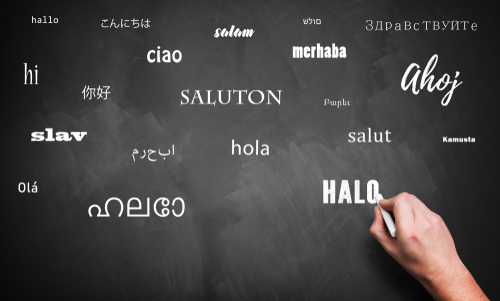Communication and connection are at the core of being human. Interacting with others and the world around us is critical not only for collaboration and progress but also for inclusion and belonging.
It’s ironic, then, that something as universal as language can be so limiting. Language differences significantly impact people’s ability to connect with one another, and it’s something we’ve all experienced, no matter where in the world we are.
I was confronted with this reality recently while watching a show primarily spoken in Spanish. My attention was split between the action and the translated captions at the bottom of the screen, and my mind flickered every time I heard a Spanish word or idiom I recognized. It was even more confusing when they used a word I hadn’t learned for something I thought I knew. For example, I learned the Spanish word for money as “dinero,” but the characters used “plata.” I had known boss to be “jefe,” but instead, they said “patron.” It made me think of the multilingual employees at my own global organization: Does every meeting, every e-mail, every notification require their minds to operate on two—or three or four—different levels the way mine was while watching a show in another language?
The Invisible Work of Multilingual Employees
It takes a tremendous amount of effort to learn a new language at any stage in one’s life, never mind the challenge of balancing multiple languages while trying to meet company expectations. Businesses are constantly seeking multilingual employees, recognizing the value of individuals who don’t have to overcome a language barrier to communicate with customers, vendors, and other stakeholders. In fact, 9 out of 10 U.S. employers say they rely on employees who can speak languages other than English. This demand makes good business sense: Companies that employ multilingual individuals deliver improved customer service, cultivate deeper customer relationships, and experience faster expansion.
And yet, it seems multilingual employees aren’t always appropriately recognized for their skills. When I spoke to bilingual employees at various companies, including my own, they expressed feeling underappreciated and said they have leaders or colleagues who sometimes don’t understand the challenges they face speaking and processing things in multiple languages. How often do we, as native English speakers, stop to ask ourselves whether we’re speaking too quickly for non-native speakers? How often do we consider whether we overuse U.S.-specific idioms that wouldn’t make sense to the rest of our global audience?
Language is not only a key part of inclusion and belonging in the workplace but also a key part of who we are as human beings. How many of us have traveled to a country that speaks an unfamiliar language? How did you feel when you were in the presence of someone who did speak your native tongue? Relieved? Safe? Understood? We could apply this same concept to the way we work with one another. We may not be fluent in someone else’s native tongue, but we should create a workplace where they can feel psychologically safe and appreciated when they work with us. There are several ways to make multilingual employees feel seen, heard, and understood.
Keep the Language Barrier in Mind …
This may sound obvious, but when the workday is filled with meetings, e-mails, and action items, it’s easy to forget that some colleagues are mentally jumping between languages. Paying attention to the rate at which you speak could go a long way. Trying to keep up with someone speaking rapidly in their native language can be confusing at best and overwhelming at worst.
Additionally, it might be helpful to reduce the number of idioms used in regular conversation. A phrase like “making mountains out of mole hills” might be lost on someone who isn’t a native English speaker. And if you do use phrases like this, be sure to explain what they mean.
Finally, it’s essential to ensure your ideas and directions are clear. Don’t assume that because you said it, everyone understands. Don’t let things get lost in translation—no pun intended.
… But Don’t Make It the Focus of the Conversation
While it helps to make sure everyone understands what’s being said, comments about accents or mispronunciations are never acceptable. If you truly didn’t understand what your multilingual employees said, ask for clarification. You’d expect them to do the same with you.
Bridge the Gap
Try to learn some words or phrases in your employees’ native languages. Knowing “hello,” “goodbye,” “how are you,” “yes,” and “no” can make a major impression. It can help remove the barrier between multilingual and monolingual employees, and it shows you recognize the effort they put in to speak a non-native language.
With more businesses and organizations seeking multilingual employees, and with evidence showing these employees positively contribute to companies’ cultures and bottom lines, acknowledging their value is critical. With some simple changes in communication, we can make our multilingual employees feel more valued and appreciated, which should always be a point of focus for leaders who strive to build a more inclusive workplace.
Shirley Knowles is Chief Inclusion and Diversity Officer at Progress.

